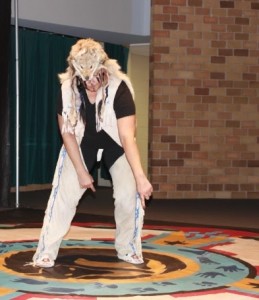After a “Culture Stew” about Native American sports and a colorful play that brought life to legends about the naming of animals and creation of fire, St. Thomas’ celebration of National Native American Heritage Month is underway.
Student Diversity and Inclusion Services partnered with faculty and staff, including English professor Liz Wilkinson, to raise awareness of Native American culture throughout November.
“I feel like we need to raise awareness of Native cultures,” Wilkinson said. “We’re on Dakota ground. This is not our land.”
Wilkinson kicked off the week with a “Culture Stew” revolving around her two areas of expertise: Native American literature and sports literature.

“Basically the premise of my talk was that people often, when I say Native Americans in sports, think of the mascot issue. And I think that one of the things that’s wrong with people – teams – using Native American caricatures as mascots is that it takes the storytelling power away from the people,” Wilkinson said.
While Wilkinson spoke about the weakening of storytelling, Mixed Blood Theatre actress George Keller used her talents to tell a unique story about Native American legends. She performed John Kauffman’s play “According to Coyote,” playing the role of Coyote, a brave, foolish and sneaky character who gave accounts of the origins of various Native American traditions.
Senior Elena Espana-Regan said she thought the play, which was performed in O’Shaugnessy Education Center, was important for members of the St. Thomas community.
“It highlights the existing diversity because this is a college where you can go through your day and not realize that there is diversity on campus, and that’s not really fair because it does exist,” Espana-Regan said.
“According to Coyote” made freshman Brenna Carberry think about diversity beyond St. Thomas.
“This is not even representative of all the Native people, you know? And so I think that’s important – just the fact that there’s so many,” Carberry said. “So it doesn’t necessarily have to be representative of St. Thomas, but just representative of anyone – just to make you think about other stuff that’s not you.”
According to Wilkinson, not thinking about that “other stuff” has taken a toll on many people’s idea of Native American culture.
“I think there are still a lot of misconceptions. And a lot of people’s information about Native peoples is one dimensional and comes from Walt Disney,” Wilkinson said. “I know a ton of people can sing the ‘Pocahontas’ theme song from Disney but don’t know about the two major tribes in Minnesota.”
Espana-Regan attributed these Disney notions to the minimal education about Native Americans students get in school.
“It gives us this image of them that is frozen in the past – like Pocahontas is all we know,” Espana-Regan said.
Other events this month, such as the screening of “The Dakota 38” and a speech on Native American mascots, aim to diminish these common misconceptions while others, like performances by Native dancers, help to celebrate Native American culture, which is essential for senior Lexi Tarter.
“It’s really important to celebrate the diversity we have on campus. Compared to other areas around where we live, we’re not the most diverse area,” Tarter said. “And so, when we can bring that to the forefront of people’s attention, I think it’s really powerful.”
Above all, Wilkinson said there is one big takeaway about Native American culture students should understand.
“It’s broader than just Pocahontas and mascots,” she said.
Theresa Bourke can be reached at bour5445@stthomas.edu.

